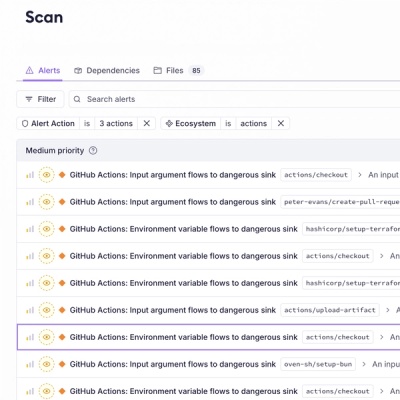
Product
Introducing Socket Firewall Enterprise: Flexible, Configurable Protection for Modern Package Ecosystems
Socket Firewall Enterprise is now available with flexible deployment, configurable policies, and expanded language support.
@economist/component-ad-panel
Advanced tools
An advert panel using GPT tags
This component expects an ES6 environment, and so if you are using this in an app, you should drop in a polyfill library - it has been tested with babel-polyfill but core-js or es6-shim may also work.
The default export is a React Component, so you can simply import the component and use it within some JSX, like so:
import Adpanel from '@economist/component-ad-panel';
return <Adpanel/>;
For more examples on usage, see src/example.es6.
adTag (required string): The DFP tag this points to. Often in the format of a URL. example: /5605/foo.bar/qux/x.className (string): Add this className to ad-panel__container.sizes={[
[ 60, 60 ],
[ 70, 70 ],
[ 300, 250 ],
[ 1024, 768 ]
]}
``` (array of pairs of advertisement width, height): what ad sizes can be loaded. Is used as the size argument to googletag.defineSlot
sizeMapping={[ [[980, 200], [[1024, 768]]], [[0, 0], [[300, 250]]], ]} ``` (array of pairs of screen sizes [ width, height ] and advertisement sizes [ [width1, height1], [width2, height2], ... ] ): Each element in this array results in a call to sizeMapping().addSize
targeting (array of pairs of key/value strings): Defines the ad targeting. Each element corresponds to a call to setTargetingreserveHeight (number of px): Sets a min-height to the ad, so as to avoid content jumps when the ad eventually comes around.googletag (instance of the googletag object): Mostly a testing hook, but can be passed to avoid loading the DFP tag again, if it was already loaded.The lazyload prop has been removed as the feature was making this component unmaintainable and bug-prone. From now on you can use the excellent react-lazy-load. Here's an example:
// Before:
<AdPanel lazyLoad {...otherProps} />
// After:
<LazyLoad>
<AdPanel {...otherProps} />
</LazyLoad>
The animated prop has also been removed, and its relevant CSS with it. This feature can also be implemented very easily using LazyLoad (and some classNames):
// Before:
<AdPanel animated {...otherProps} />
// After:
class AnimatedAd extends React.Component {
render() {
const className = this.state && this.state.visible ?
'animated-ad-wrapper animated-ad-wrapper--visible' :
'animated-ad-wrapper';
return (
<div className={className}>
<LazyLoad onContentVisible={() => { this.setState({ visible: true }) }}>
<AdPanel {...this.props} />
</LazyLoad>
</div>
)
}
}
<AnimatedAd {...otherProps} />
Both work exactly the same.
npm i -S @economist/component-ad-panel
npm test
FAQs
An advert panel using GPT tags
We found that @economist/component-ad-panel demonstrated a not healthy version release cadence and project activity because the last version was released a year ago. It has 1 open source maintainer collaborating on the project.
Did you know?

Socket for GitHub automatically highlights issues in each pull request and monitors the health of all your open source dependencies. Discover the contents of your packages and block harmful activity before you install or update your dependencies.

Product
Socket Firewall Enterprise is now available with flexible deployment, configurable policies, and expanded language support.

Security News
Open source dashboard CNAPulse tracks CVE Numbering Authorities’ publishing activity, highlighting trends and transparency across the CVE ecosystem.

Product
Detect malware, unsafe data flows, and license issues in GitHub Actions with Socket’s new workflow scanning support.